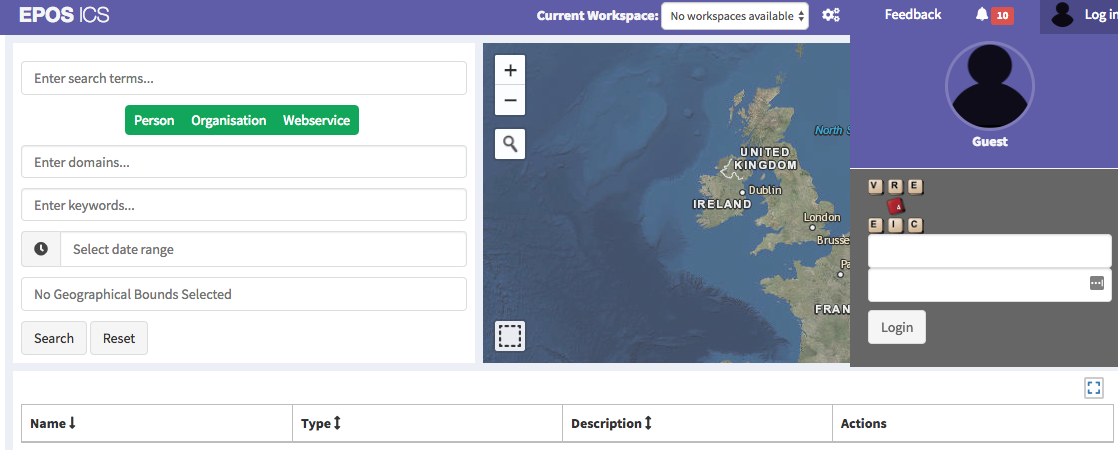Brief Description of the project
VRE4EIC (A Europe-wide Interoperable Virtual Research Environment to Empower  Multidisciplinary Research Communities and Accelerate Innovation and Collaboration) develops a reference architecture and software prototypes (under the name of e-VRE, for enhanced VRE) to be used for future VREs including building blocks that can be used to improve existing VREs. The project addresses the key data and software challenges in supporting multidisciplinary data driven sciences. Multidisciplinary Research Communities and Accelerate Innovation and Collaboration) develops a reference architecture and software prototypes (under the name of e-VRE, for enhanced VRE) to be used for future VREs including building blocks that can be used to improve existing VREs. The project addresses the key data and software challenges in supporting multidisciplinary data driven sciences.
Achievements
VRE4EIC has successfully developed a reference architecture and software components for Virtual Research Environments (VREs). e-VRE (enhanced VRE), designed to build or enhance e-Research Infrastructures (e-RIs) provides a comfortable homogeneous interface for researchers and developers by virtualising access to the heterogeneous datasets, software services and resources of the e-RIs. On top of this, it also supports collaboration and communication between users/researchers.
 |
The potential of e-VRE is demonstrated by the European Plate Observing System (EPOS) and ENVRIplus, a Horizon 2020 project bringing together Environmental and Earth System Research Infrastructures, projects and networks. Both EPOS and ENVRIplus are represented in the project, themselves supported by e-Infrastructures such as GEANT, EUDAT, PRACE, EGI, OpenAIRE.
VRE4EIC provides a superset canonical rich catalog into which information from the distributed heterogeneous e-RI catalogs is imported via convertors. It thus provides a homogeneous view over the heterogeneous metadata describing the assets and thus automates findability and accessibility. Access to the catalog is offered via the Metadata Manager component of the reference architecture, encapsulating all operations on the descriptions held in the catalog. The Metadata Manager was included in the architecture of EPOS, enhancing EPOS’ interoperability level.
|
 |
|
The current state of the art has some interoperability and re-use among research assets but this is usually restricted to a particular domain where local metadata standards are utilised. However, the interoperation usually requires considerable human effort and rarely is (even partially) automated. The VRE4EIC catalog will allow homogeneous access across the heterogeneous metadata provided, and thus —progressively—interoperability and re-usability.
The project has produced a series of video tutorials about VREs in general, and the VRE4EIC reference architecture and component services in particular. The e-VRE source code is available on GitHub.
e-VRE Architecture and Software released
The project has completed and released the final version of the Reference Architecture (Canonical Reference Prototype -CRP), which is described in the public deliverable D3.5 available on the web site. Beyond the description of the architecture, it describes its implementation and its validation through the enhancement of the EPOS (see also the EPOS success story below) and the ENVRIplus VREs.
All software components (“building blocks”) of the Reference Architecture have been developed and released.
The available software components include:
- The AAAI Service, providing now a two-factor authentication (2FA) method;
- The Metadata Service – including functionalities for harvesting data from external Research Infrastructures and for thesaurus management;
- The Node Service – including functionalities for maintaining configuration information, naming, and providing distributed synchronization in distributed installations of e-VRE;
- The App service - providing the basic life cycle management for external applications, including workflows, including a distributed configuration service, synchronization service, and naming registry to allow microservices to be deployed and launched on any machine, so that e-VRE can be deployed on a distributed architecture.
- The Workflow Service - implementing a set of functionalities that can be used by external workflow frameworks to build workflows including the services described in the e-VRE Metadata service (implemented on top of the Taverna Technology).
In addition, the Graphical User Interface for e-VRE has been designed and completed.
Video Tutorials
 The project has produced a series of video tutorials. Short online videos are explaining how to build a Virtual Research Environment (VRE) or to enhance an existing VRE. The project has produced a series of video tutorials. Short online videos are explaining how to build a Virtual Research Environment (VRE) or to enhance an existing VRE.
With this series of tutorial videos, scientists and engineers can now learn how to build a VRE or enhance the functionalities of an existing VRE. Experts explain in a way easy to understand the different items and aspects of e-VRE: Keith Jeffery from ERCIM gives an introduction “What is a Virtual Research Environment”. Carlo Meghini from CNR gives insight in "e-VRE architecture design & implementation”, explaining the architecture as well as set of software systems and tools of e-VRE. Laurent Remy from euroCRIS teaches how to manage metadata in Virtual Research Environments.
In a tutorial explaining VRE requirements, Yi Yin form Delft University of Technology discusses the question "what do VRE users need?". Anneke van Zuiderwijk from Delft University of Technology investigates and compares in her tutorial seven cases of supporting researchers in open data analysis.
Maria Theodoridou, FORTH, presents the VRE4EIC Metadata Portal. The first part of her tutorial introduces the core components and explains how to construct a basic query. The second part demonstrates advanced features of the portal: how to use the geographical map, how to expand basic into complex queries, and how to store and load queries. The VRE4EIC AAI - Authentication & Authorization Infrastructure is explained by Jacco van Ossenbruggen from CWI in part 1 of this tutorial on trust. In the second part of his tutorial he explains “Trustable Computing in Open Science”.
Further videos explain how to use e-VRE to enhance an existing VRE. Daniele Bailo from the Italian National Institute for Geophysics and Volcanology (INGV) explains how building blocks (software tools) provided by VRE4EIC are enhancing an existing Research Infrastructure such as the European Plate Observation System (EPOS). Zhiming Zhao from University of Amsterdam (UvA) presents how the ENVRIplus community uses e-VRE architecture and building blocks for enhancing research infrastructures from different environmental and earth science domains.
Enhancing Research Infrastructures with VRE4EIC components: the EPOS Success Story
The European Plate Observing System (EPOS) highlights how its research infrastructure has become more efficient and user-friendly by utilizing technology developed in the frame of the EU H2020 VRE4EIC project.

In the last decades quite an amount of tools, technologies and software has been developed to support and improve research throughout the entire data lifecycle . This includes software, modeling tools, and even code that can be used and re-used by researchers around the world. However, more and more emphasis has been given to the structural components that enable a Research Infrastructure to be sustainable, robust and, even most importantly, compliant to the FAIR principles . Such principles prescribe--in order to enable reproducible science--that data need to be findable, accessible, interoperable and reusable. It is usually up to research infrastructure designers, developers and managers to find the best architecture and technologies to enable FAIR to become reality in their scientific domain. However, looking transversally at science domains, it is clear that there is a number of challenges common to several communities, as evidenced by the common requirements elicitation and analysis of existing technical assets carried out both in the VRE4EIC and ENVRIplus projects .
In this framework, VRE4EIC is promoting the adoption of common, standard technical solutions in order to facilitate Research Infrastructures in facing shared challenges and thus complying with FAIR principles.
This is the case of the European Plate Observing System (EPOS), a Distributed Research Infrastructure, in long-term plans to facilitate integrated use of data, data products, and facilities from distributed research infrastructures for solid Earth science in Europe.
In order to enable Accessibility (the “A” of FAIR), the EPOS central hub, that provides access to a wealth of different types of data and services from communities, had to implement appropriate Authorization mechanisms. Such mechanisms are usually referred to as “AAAI”, which stands for Authentication, Authorization, and Accounting Infrastructure. Instead of creating such an infrastructure “from scratch”, EPOS took advantage of the existing VRE4EIC “AAAI Service” building block. This component provides a “plug-and-play” solution for the authentication of users, and in addition it integrates different authentication mechanisms from various AAI providers (e.g. eduGAIN, Facebook, Google and others) in one single system. Due to its integrability into service-based architecture, it can be easily plugged into micro-services-oriented architectures , such as the one of EPOS.

Figure 1: Example of integration of VRE4EIC Authentication services (AAAI) into EPOS central hub Graphic User Interface (GUI). The login box is rendered on the EPOS GUI, but actually managed and ran by VRE4EIC Authentication service building block. Such component is part of the VRE4EIC prototype and runs on VRE4EIC servers made available by project partners (in this case CNR ISTI – Pisa).
The EPOS User Interface is presented in Figure 1. It enables the discovery and search of datasets in the solid Earth domain, which includes several communities such as Seismology, GPS, satellite data, volcanic observatories and others. An authentication widget is also available for access to the specific dataset. The authentication in this case is managed by the VRE4EIC AAAI service component, which is simply “plugged-in” into EPOS main system.
Starting from this first pilot, EPOS has also benefitted from VRE4EIC studies and developments in other fields. For instance for the workflow management and the metadata system architecture (both projects use the CERIF model).
The EPOS use case has several important implications. The first one is that this pilot has demonstrated the suitability of the strategy adopted by VRE4EIC for supporting and enhancing e-Research Infrastructures, in particular with respect to the AAAI service.
The second one, related to research infrastructure sustainability, is that it saved efforts in integrating authentication services on EPOS, with all related technical and security issues, not to counting the development efforts that were optimized by adopting an EU-funded solution.
Third, on the user side, it allows end users to access through existing credentials from Facebook, eduGAIN, and other Identity Providers, to log in easily to EPOS or any other Research Infrastructure enhanced by VRE4EIC Authentication service.
Now, a future-oriented exercise is due: imagine that many other research infrastructures would use such shared solutions produced by VRE4EIC. How much development and sustainability efforts would they save by integrating in an easy way metadata catalogue services, AAAI services, and other common solutions?
The answer is not trivial, also because other players are available on the EU landscape. However, the expertise brought in by a pool of scientist and engineers in VRE4EIC, strongly connected with the communities, and with skills in the integration of several research infrastructures in various domains, is doubtless precious and capable of optimizing the technical dimension and sustainability, as demonstrated by the EPOS pilot.
VRE4EIC website: /
VRE4EIC tutorials: /tutorials
VRE4EIC GitHub: https://github.com/vre4eic
|
|






